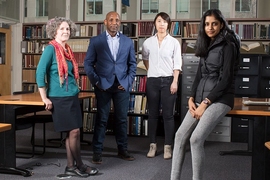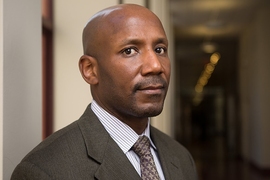In 1882, MIT students socialized in a drawing room that featured a replica of J.M.W. Turner’s painting, “The Slaveship,” which shows enslaved people drowning, thrown overboard during a storm as expendable cargo. The students’ commentary centered on the painting’s bold colors, but ignored the violent human narrative.
On Friday, Feb. 16, MIT senior Alaisha Alexander stood under a projection of that haunting image, and noted that absence in the campus dialogue of the time. Early MIT coursework also referred to scientific literature that validated slavery, she said, without encountering opposition from professors or students. “It’s not just about what is taught at a university. It’s also about what isn’t,” said Alexander, a mechanical engineering student. “Science and technology aren’t neutral.”
Alexander and other MIT students have begun exploring the university’s entanglement with the institution of slavery, in the process writing a more complete history, and helping to catalyze a national conversation about the legacies of slavery in science, engineering, and technical education. The source of this momentum is a new, ongoing undergraduate research course, “MIT and Slavery,” (21H.S01). Set in motion by MIT President L. Rafael Reif with School of Humanities, Arts, and Social Sciences (SHASS) Dean Melissa Nobles, the course was developed and taught by Craig Steven Wilder, the Barton L. Weller Professor of History and the nation’s leading expert on the links between universities and slavery, in collaboration with Nora Murphy, the MIT Archivist for Researcher Services.
How can history help us invent a better future?
The power of stories and seeking the facts were primary threads of discussion among the nine speakers during Friday’s event, the first of the “MIT and the Legacy of Slavery” dialogues that will engage the MIT community in considering responses to the course findings. A single MIT course rarely prompts community-wide conversations, but the research of the “MIT and Slavery” course speaks not only to more complete understanding of the Institute’s own history, but to the roots of ongoing culture-wide issues of justice, inclusion, and human rights.
“I believe the work of this class is important to the present — and to the future,” President Reif said in his welcoming remarks to around 200 faculty, students, alumni, and a livestream audience at the event. “Something I have always loved about the MIT community is that we seek, and we face, facts. What can history teach us now, as we work to invent the future? How can we make sure that the technologies we invent will indeed contribute to making a better world for all?”
The power of facts — and stories
Four MIT students from the first class presented well-researched information and narratives — previously obscured, forgotten, ignored — that shed new light on the history of science and technology in the U.S. One of many revelations unearthed in the course involves the story of MIT’s founder and first president William Barton Rogers. As Murphy discovered in the U.S. Census Slave Schedule of Virginia, before Rogers moved to Massachusetts in 1853, he owned six enslaved people, who, according to the census records, lived in his Virginia household.
This discovery hardly surprises scholars such as Wilder. In his words, “If we're surprised, our surprise is a measure of how successful we’ve been as a nation at erasing the history of slavery,” including its pervasive links with the economy and major institutions, in the Northeast as well as the South. Many U.S. engineering schools, for example, were originally funded by families whose wealth derived from textile, sugar, and mining operations, which depended, directly or indirectly, on the labor of enslaved people.
A new space for research and conversation
All the early findings from the new course, and those from future classes, will contribute to advancing a national dialogue, Wilder said: “We are not only participating in a larger exploration of the ties between American universities and slavery, we are leading a part of it.” Wilder said he hopes the MIT project inspires other science and technology institutions across the country to revisit their histories, and to form a collaborative research effort on the relationship between science, engineering, and the slave economies of the Atlantic World. Wilder is partnering with colleagues at New York University to convene several schools this spring to launch the initiative.
“The goal of our work is to collectively tell our story in the most honest, complicated, full, and transparent way that we can,” Wilder said during Friday’s event. Such a narrative will create space for much better conversations on campuses, in cities, in states, and across the country, he explained, adding that “what we mean by race, social justice, inclusion, and diversity” for the present and the future can only be understood when seen against an accurate historical backdrop.
Fundamental to the nation's history
In 1861, when MIT was founded, the political and social order in the U.S., along with its economy, was still fundamentally shaped by the institution of slavery, said Nobles, who provided an overview of the cultural and economic context in which MIT was founded, and will lead MIT’s process of community discussions to consider responses to the “MIT and Slavery” course findings.
The legacy of slavery is enmeshed in the histories of many of the country’s oldest and most prestigious institutions, said Nobles, who is also a professor of political science at MIT. “Slavery was so fundamental to our country’s history, economy, and politics that it would only be surprising if there were no connections at MIT.”
Indeed all scientific knowledge is embedded in a social context, said the course’s teaching assistant Clare Kim, a fifth-year PhD candidate. Her students visited the MIT archives and pored over old issues of the student newspaper The Tech and the MIT yearbook Technique. They also read faculty minutes, course catalogs, and a wealth of secondary source materials.
“These students interrogated not only our assumptions about MIT and slavery — but also race, science, and technology,” Kim said. She urged the audience to do more than passively receive the facts the class has found. “Go back to your labs and offices and look at your environment. Consider how the way you think about MIT — and science and technology — includes traces of the histories you are about to hear today.”
Insights from MIT students
Gasps were audible as Alexander, the mechanical engineering student, delved into early MIT silence around “The Slaveship” painting and other racialized art and literature. She ended her presentation by saying, “I encourage you to think about where different notions of science come from.”
Visual images were also the focus of first-year student Kelvin Green II’s research. Combing through early MIT student publications, Green II strove to understand early campus attitudes through the images that MIT students drew. He found racialized and mocking images of African-Americans; hooded figures evocative of the Klu Klux Klan; and an absence of images depicting African-Americans as students or engineers — an absence at odds with the actual occupations of black male Bostonians during the 1881-1911 time period.
When asked about the impact of these slavery-related findings on black students at MIT today, Green II reflected: “How do you quantify the experience of a black student confronted with the images I’ve put up?” Understanding racism, he continued, requires qualitative analysis, including listening to the stories of those most affected by it. “Engage in dialogue. If you don’t have a black friend, make a black friend!” he said to applause.
Sophomore Mahalaxmi Elango dug into MIT’s early curriculum for her project, and discovered not only an early focus on mining — an industry that had relied heavily on enslaved people — but also that slavery was a subject for academic discussion at MIT. A popular course in moral philosophy, for example, explored the relationship between technology and the economies of labor, including the labor of enslaved people. An 1873 political economy exam asked: “Define Labor, and prove that the service of slaves, or any involuntary work, is not labor in the economic sense.”
Charlotte Minsky, a sophomore majoring in earth, atmospheric, and planetary sciences, examined the careers of students who came to MIT in its first 15 years and found a large concentration of these students went into the railroad industry. She speculated that this focus emerged from the need to rebuild the South after the Civil War. “It’s essential to the narrative of early MIT that there’s a flow of money and ideas from the South to the North in the era of Reconstruction,” she said. Of MIT’s investigation into slavery, Minsky observed, “MIT is setting a precedent for similar institutions. We are showing that connections to slavery are very nuanced, and that science and technology are an aspect of this history that can longer be left in the wings.”
Raising questions
What skepticism there is about the “MIT and Slavery” research course takes the form of questions like the following, posed by a livestream viewer: “What gives anyone today the right to judge the actions of people in the distant past by modern popular moral standards?”
Wilder welcomed the opportunity to address that question. “Birth gives us the right,” he said, with a chuckle. “The idea that to judge the past by modern moral values is somehow ahistorical misunderstands what history is. History is the science of thinking about the past and how it influences the present.” The MIT community is capable of thinking about the past in constructive ways, he added. “One of the goals of the project is to create opportunities for us as a community — as communities — to wrestle with difficult issues in dialogue in a democratic and open way.”
Another community member asked one of the questions the project raises for education: “What would you say the implications of MIT’s findings are for teaching science and the history of science?” As an initial response, Kim noted that the “MIT and Slavery” course will itself be one example, continuing to research and share discoveries about the relationship between science, technology, and the social realities of which they are a part. She added, “We are asking people to think differently.”
Looking ahead
The value of this ongoing exploration is immeasurable, President Reif said. “If we have the courage to look at even the troubling parts of our history,” he said, “I believe we have a much better chance of approaching the present and the future with humility and self-awareness.”
The MIT and Legacy of Slavery dialogue will continue at MIT, led by Nobles who will announce plans for new opportunities to contribute ideas and reflections later this spring. The process Nobles envisions will be one of “looking at old things with new eyes.” In the meantime, and in parallel with the Institute-wide conversation, updates and information on the “MIT and Slavery” course findings will be posted to the course website.
Story prepared by SHASS Communications
Editorial team: Meg Murphy and Emily Hiestand














